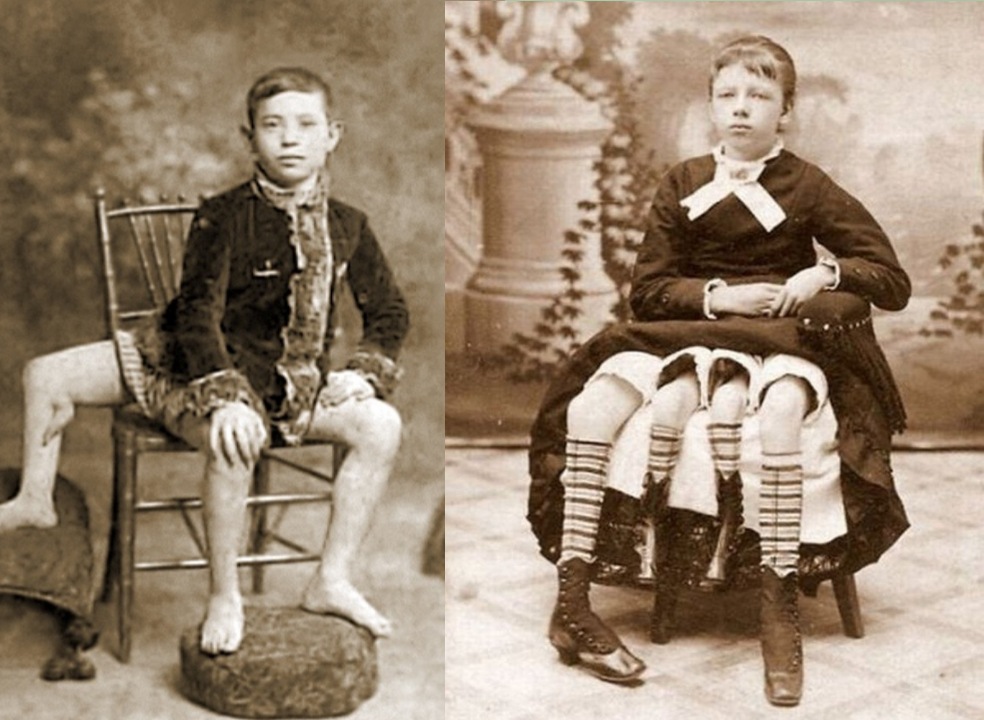DIPYGUS: Frank Lentini, Josephine Corbin, the Three- and Four-Legged Sideshow Performers

Did you know that dipygus is a severe congenital deformity where the body axis forks left and right partway along the torso with the posterior end (pelvis and legs) duplicated?
Dipygus deformity is a severe and extreme form of caudal duplication where the body axis completely duplicates at the caudal end. Genetic, environmental or teratogenic factors are presumed to be implicated early in the intrauterine life thereby affecting the embryonic cloaca and notochord derivatives which leads to uninhibited fission of the germinal disc at the caudal end and arrested fission rostrally.
Dipygus manifests as duplicated lower limbs and could include additional organs or bodily structures. It is caused by genetic, environmental, or teratogenic factors and occurs early in intrauterine life. In dipygus, the inner two of the four hindquarters develop much smaller than normal. This is a type of "teras catadidymum" ("monster twinned below"). Another sort of deformity with extra legs can happen from a degenerated conjoined twin.
Only two cases of dipygus were reported in the English literature till date – the famous Francisco "Frank" Lentini and Josephine Myrtle Corbin, who went on to live for many years begetting children.
Lentini was born on May 18, 1889 to an Italian-American sideshow performer who toured with numerous circuses. Born with a conjoined twin, Lentini had three legs. The twin was attached to his body at the base of his spine and consisted of a pelvic bone, a rudimentary set of male genitalia, and a full-sized leg extending from the right side of his hip, with a small foot protruding from its knee.
Lentini was exhibited in numerous cities, including London, in 1897. When he was eight, Magnano, who ran a travelling puppet show, brought him to Middletown and Lentini's family moved to the United States. Lentini then entered the sideshow business as The Great Lentini, joining the Ringling Brothers Circus. He gained US citizenship at the age of 30. His career spanned over 40 years and he worked with every major circus and sideshow, including Barnum and Bailey and Buffalo Bill's Wild West Show. He was so respected among his peers that he was often called "The King".
In 1907 he married Theresa Murray, three years younger than him, and they had four children: Giuseppina (Josephine), Natale (Ned), Francesco (Frank) Junior, and Giacomo (James). When Frank and Theresa separated around 1935, he began a new life with Helen Shupe, with whom he lived until his death from lung failure in Jackson, Tennessee, on September 21, 1966, at the age of 77.
Corbin, an American, was born on May 12, 1868, as a dipygus. She had two separate pelvises side by side from the waist down, as a result of her body axis splitting as it developed. Each of her smaller inner legs was paired with one of her outer legs. She was said to be able to move her inner legs, but they were too weak for walking.
Corbin entered the sideshow circuit with the moniker "Four-Legged Girl from Texas" when she was 13 years old. Her popularity in this industry was such that other showmen turned to exhibiting four-legged gaffs (falsified performances). When Corbin herself was no longer performing, there were several phony four-legged women to whom audiences could turn.
At age 19, Corbin married James Clinton Bicknell, with whom she had four daughters and a son. She died in Cleburne, Texas, on May 6, 1928. Her casket was covered in concrete and various family members kept watch until it was fully cured. This was to prevent grave robbers from stealing her corpse. Several medical practitioners and private collectors had offered financial compensation for her corpse.
#penglobalentertainment #dipygus



